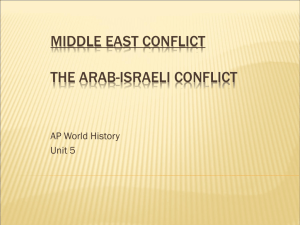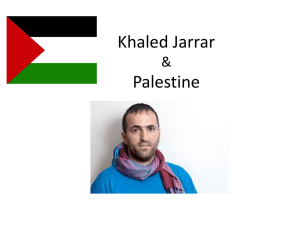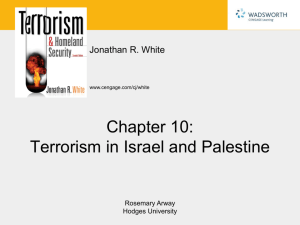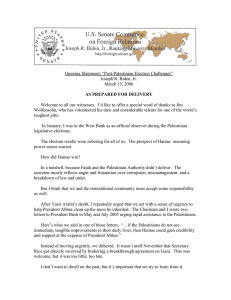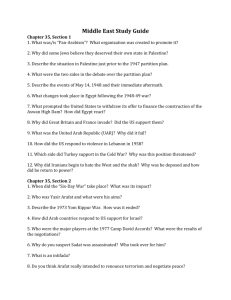1 DSC4012 – TERRORISM Chapter 9 - Terrorism in Israel and Palestine
advertisement
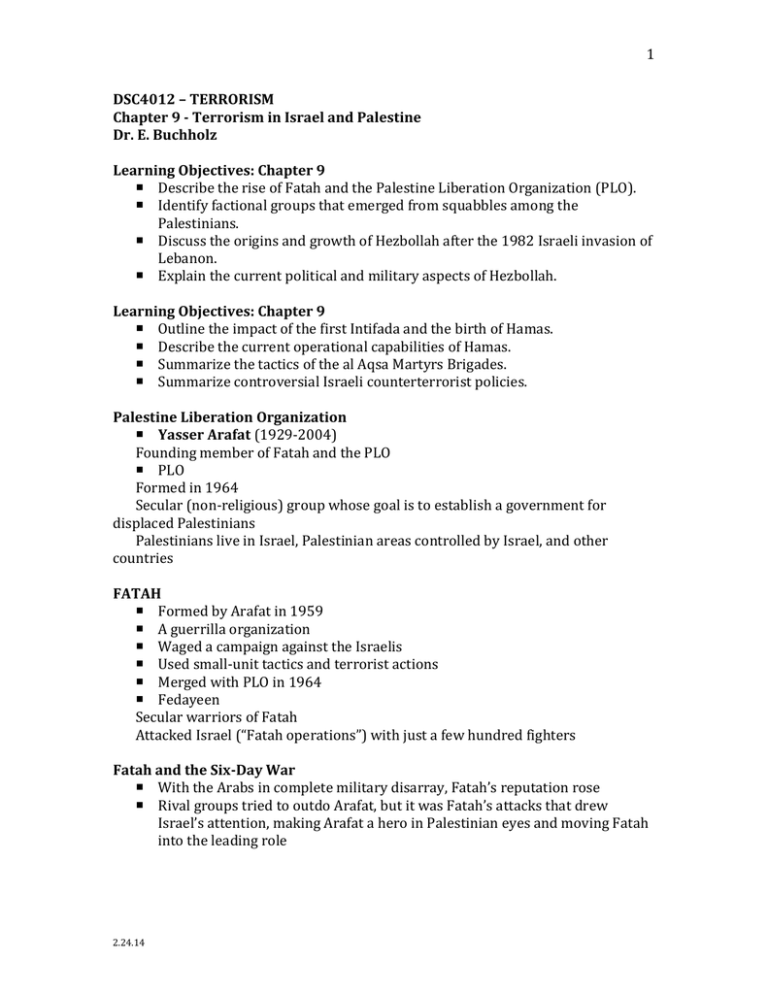
1 DSC4012 – TERRORISM Chapter 9 - Terrorism in Israel and Palestine Dr. E. Buchholz Learning Objectives: Chapter 9 Describe the rise of Fatah and the Palestine Liberation Organization (PLO). Identify factional groups that emerged from squabbles among the Palestinians. Discuss the origins and growth of Hezbollah after the 1982 Israeli invasion of Lebanon. Explain the current political and military aspects of Hezbollah. Learning Objectives: Chapter 9 Outline the impact of the first Intifada and the birth of Hamas. Describe the current operational capabilities of Hamas. Summarize the tactics of the al Aqsa Martyrs Brigades. Summarize controversial Israeli counterterrorist policies. Palestine Liberation Organization Yasser Arafat (1929-2004) Founding member of Fatah and the PLO PLO Formed in 1964 Secular (non-religious) group whose goal is to establish a government for displaced Palestinians Palestinians live in Israel, Palestinian areas controlled by Israel, and other countries FATAH Formed by Arafat in 1959 A guerrilla organization Waged a campaign against the Israelis Used small-unit tactics and terrorist actions Merged with PLO in 1964 Fedayeen Secular warriors of Fatah Attacked Israel (“Fatah operations”) with just a few hundred fighters Fatah and the Six-Day War With the Arabs in complete military disarray, Fatah’s reputation rose Rival groups tried to outdo Arafat, but it was Fatah’s attacks that drew Israel’s attention, making Arafat a hero in Palestinian eyes and moving Fatah into the leading role 2.24.14 2 Battle at Karamah Israelis staged an attack on a village in Karamah, Jordan harboring fadayeen. Meant to be a hit-and-run attack. Sent in infantry and tanks, then withdrew even though they were about to overrun the fedayeen. The legend of the battle as told of Fatah’s fedayeen was that of defeating the Israeli Defense Forces. Millions were donated, corrupting the PLO leadership, making it the most powerful Palestinian group. The PLO Expelled As the PLO grew, it drew closer to militant Arab states, giving them a potential base in Jordan King Hussein of Jordan ordered Arafat to stop its attacks Radical elements in Iraq and Syria encouraged Arafat to defy Hussein’s order Hussein attacked the PLO in 1970 Arafat fled to southern Lebanon Black September and Munich Arafat blamed Israelis for Hussein’s actions Due to the splintering of the PLO, he created a new group--“Black September” Using German leftist allies, Black September began planning a strike against the Israelis Black September struck the 1972 Olympic Village and took most of the Israeli Olympic team hostage, killing those who tried to escape 1982 Invasion of Lebanon Massive 3-pronged Israeli Defense Force invaded Lebanon PLO was surrounded and bombarded by Israelis in Beirut Arafat fled Beirut for Tripoli with 14,000 fedayeen, 10,000 guerrillas stayed and joined the Syrians. Palestinian Terrorism From 1967 to 1982, the PLO was characterized by internal splintering Arafat found that he could not retain control of the military wing, and several groups split from it New groups formed after the 1982 invasion of Lebanon, including Hezbollah and Hamas Major Groups Abu Nidal Organization Al Aqsa Martyrs Brigades Black September Democratic Front for the Liberation of Palestine Fatah Force 17 2.24.14 3 Hamas Hezbollah Major Groups Palestinian Islamic Jihad Palestine Liberation Front Popular Democratic Front for the Liberation of Palestine Popular Front for the Liberation of Palestine Popular Front for the Liberation of Palestine, General Command Tanzim Brigade Hamas Islamic Resistance Movement Palestinian wing of the Muslim Brotherhood Accept violence as a norm Primary mission is to oppose the PLO Its military wing is the Izz el Din al Qassam Brigades 2004, Israel assassinated their spiritual leader, Sheik Ahmed Yassin As soon as he was replaced, the Israelis killed him too Hezbollah The Iranian-backed Party of God Operates from southern Lebanon Forms alliances of convenience with other organizations participating in the al Aqsa Intifada An uprising sparked by Ariel Sharon’s visit to the Temple Mount with a group of armed escorts in September 2000. Characterized by suicide bombings. Has been referred to as the deadliest terrorist group in the world. The Origins of Hezbollah Hezbollah’s roots can be traced to a desire to export revolutionary ideals from Iran and Shi’ite emancipation in Lebanon Hezbollah grew from a council of Shiite scholars who claimed to be part of a spiritual movement Hezbollah developed under the leadership of three central figures: Sheik Mohammed Hassan Fadlallah, Abbas Musawi, and Hassan Nasrallah The Origins of Hezbollah Phase one of the Hezbollah development The Hezbollah umbrella covered many terrorist groups, including a shadowy organization known as Islamic Jihad In its second phase, Hezbollah’s leadership launched a kidnapping campaign in Beirut The third phase of Hezbollah’s metamorphosis came in 1990 Created a regional militia 2.24.14 4 Became primary paramilitary force in southern Lebanon A Sympathetic View of Hezbollah Many voices in Lebanon Hezbollah is a legitimate self-defense force Many Hezbollah guerrillas simply refer to themselves as the “Islamic resistance” Hezbollah is a source of inspiration After the 2006 war, support for Hezbollah grew to an all-time high Critical View of Hezbollah Hezbollah is a deadly international terrorist organization that uses international crime to finance operations Hezbollah has killed U.S. citizens and kidnapped and tortured Americans Hezbollah provided a model for the formation of an international umbrella of terrorist organizations An Overview of Hamas Hamas was formed in December 1987 at the beginning of the first Intifada Hamas’ political wing oversees internal and foreign relations The social wing runs charities, schools, hospitals, and other social service organizations in Gaza Struggles for Leadership Yassin was jailed from 1989 to 1997 Musa Abu Marzuq took over Hamas After Yassin was released from prison, he gradually reasserted control over Hamas Seeking Election In March 2004, Yassin was leaving a mosque in Gaza when Israeli helicopters appeared and fired three missiles at him The new leader was Khalid Meshal Palestinians voted Fatah out of power in January, and Hamas won the election Elections and Security Hamas won the majority of seats in the Palestinian Parliament Mahmud Abbas refused to transfer Palestinian control from Fatah to Hamas Hamas and Fatah gunmen fought routine battles; Hamas took direct control of Gaza Hamas v. Fatah Hamas controlled the majority of seats in the Palestinian Parliament, while Mahmud Abbas retained the presidency This set the stage for a confrontation 2.24.14 5 Saudi Arabia brokered a power-sharing arrangement between Hamas and Fatah Hamas had driven Fatah from Gaza, and Abbas had dissolved the government Invading Lebanon Israel launched its first invasion of Lebanon to rid the south of the PLO Ended after an eighteen-year occupation and the creation of a new enemy, Hezbollah In a war that lasted nearly a month, hundreds of Lebanese civilians were killed, nearly a million Lebanese were displaced, and Lebanon’s infrastructure was destroyed Effective Tactics The Brigades’ primary tactics have been drive-by shootings, sniper shootings, ambushes, and kidnap-murders Martyrs Brigades suicide bombers were frightening for two reasons: They were secular They sought out targets crowded with civilians Leadership in the Martyrs Brigades Brigades seem to be directly associated with their parent group, Fatah One school of thought maintains that Arafat led and paid for the Brigade Leadership in the Martyrs Brigades A BBC News investigation points to Marwan Barghouti as the commander Ja’Aire claimed that he and other Brigades commanders were under Arafat’s control Controversial Tactics Destroying the homes of suicide-bomber families Selective assassination of Palestinian leaders Killing innocents when striking militants Excessive use of force – was it? Bulldozing Purpose was to destroy the family homes of suicide bombers If militant charities and governments were going to compensate families of martyrs, the Israelis reasoned, bulldozing homes would be more painful than the pleasure of economic reward Controversial Tactics Commando raids in neighboring countries June 2006 invasion of Lebanon December 2008 invasion of Gaza Blockade of Gaza May 2010 violent interception of ships during Gaza blockade 2.24.14 6 Chapter Take Aways The modern conflict between Israel and Palestine is based in terrorism. Fatah imitated the Irgun by using terrorist tactics, but the movement was not united. Palestinian militancy is characterized by factionalism. Terrorism moved to the international arena in the 1980s, but it has remained localized for the last three decades. Chapter Take Aways The current major operational groups are Hezbollah, Hamas, and the al Aqsa Martyrs Brigades. Israeli policies are controversial. Critics claim the Israelis overreact. Defenders maintain strong tactics are necessary to counter terror. 2.24.14
